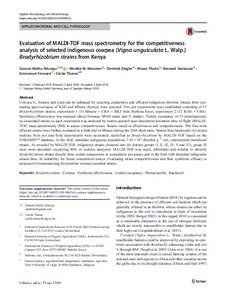| dc.contributor.author | Ndungu, S.M. |
| dc.contributor.author | Messmer, M.M. |
| dc.contributor.author | Ziegle, D. |
| dc.contributor.author | Thuita, M. |
| dc.contributor.author | Vanlauwe, Bernard |
| dc.contributor.author | Frossard, E. |
| dc.contributor.author | Thonar, C. |
| dc.date.accessioned | 2019-12-04T11:21:38Z |
| dc.date.available | 2019-12-04T11:21:38Z |
| dc.date.issued | 2018-06 |
| dc.identifier.citation | Ndungu, S.M., Messmer, M.M., Ziegler, D., Thuita, M., Vanlauwe, B., Frossard, E. & Thonar, C. (2018). Evaluation of MALDI-TOF mass spectrometry for the competitiveness analysis of selected indigenous cowpea (Vigna unguiculata L. Walp.) Bradyrhizobium strains from Kenya. Applied Microbiology and Biotechnology, 1-14. |
| dc.identifier.issn | 0175-7598 |
| dc.identifier.uri | https://hdl.handle.net/20.500.12478/3839 |
| dc.description | Published online: 25 April 2018 |
| dc.description.abstract | Cowpea N2 fixation and yield can be enhanced by selecting competitive and efficient indigenous rhizobia. Strains from contrasting agro-ecologies of Kilifi and Mbeere (Kenya) were screened. Two pot experiments were established consisting of 13 Bradyrhizobium strains; experiment 1 (11 Mbeere + CBA + BK1 from Burkina Faso), experiment 2 (12 Kilifi + CBA). Symbiotic effectiveness was assessed (shoot biomass, SPAD index and N uptake). Nodule occupancy of 13 simultaneously co-inoculated strains in each experiment was analyzed by matrix-assisted laser desorption/ionization time of flight (MALDI-TOF) mass spectrometry (MS) to assess competitiveness. Strains varied in effectiveness and competitiveness. The four most efficient strains were further evaluated in a field trial in Mbeere during the 2014 short rains. Strains from bacteroids of cowpea nodules from pot and field experiments were accurately identified as Bradyrhizobium by MALDI-TOF based on the SARAMIS™ database. In the field, abundant indigenous populations 7.10 × 103 rhizobia g−1 soil, outcompeted introduced strains. As revealed by MALDI-TOF, indigenous strains clustered into six distinct groups (I, II, III, IV, V and VI), group III were most abundant occupying 80% of nodules analyzed. MALDI-TOF was rapid, affordable and reliable to identify Bradyrhizobium strains directly from nodule suspensions in competition pot assays and in the field with abundant indigenous strains thus, its suitability for future competition assays. Evaluating strain competitiveness and then symbiotic efficacy is proposed in bioprospecting for potential cowpea inoculant strains. |
| dc.format.extent | 5265-5278 |
| dc.language.iso | en |
| dc.subject | Bradyrhizobium |
| dc.subject | Cowpeas |
| dc.subject | Nodulation |
| dc.subject | Proteins |
| dc.subject | Bacteroid |
| dc.title | Evaluation of MALDI-TOF mass spectrometry for the competitiveness analysis of selected indigenous cowpea (Vigna unguiculata L. Walp.) Bradyrhizobium strains from Kenya |
| dc.type | Journal Article |
| dc.description.version | Peer Review |
| cg.contributor.crp | Maize |
| cg.contributor.crp | Grain Legumes |
| cg.contributor.affiliation | Institute of Agricultural Sciences, Switzerland |
| cg.contributor.affiliation | Research Institute of Organic Agriculture, Switzerland |
| cg.contributor.affiliation | International Institute of Tropical Agriculture |
| cg.contributor.affiliation | Mabritec AG, Switzerland |
| cg.contributor.affiliation | Université de Liège |
| cg.coverage.region | Africa |
| cg.coverage.region | East Africa |
| cg.coverage.country | Kenya |
| cg.creator.identifier | Moses Thuita: 0000-0002-6731-9492 |
| cg.creator.identifier | bernard vanlauwe: 0000-0001-6016-6027 |
| cg.researchtheme | NATURAL RESOURCE MANAGEMENT |
| cg.isijournal | ISI Journal |
| cg.authorship.types | CGIAR and advanced research institute |
| cg.iitasubject | Cowpea |
| cg.iitasubject | Grain Legumes |
| cg.iitasubject | Natural Resource Management |
| cg.journal | Applied Microbiology and Biotechnology |
| cg.howpublished | Formally Published |
| cg.accessibilitystatus | Limited Access |
| local.dspaceid | 96092 |
| cg.targetaudience | Scientists |
| cg.identifier.doi | http://dx.doi.org/10.1007/s00253-018-9005-6 |


